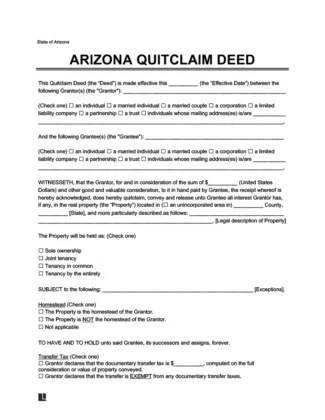

An Arizona quitclaim deed is a useful tool in transferring property when the parties do not need any title warranties. The document is typically used for property transfer within families or divorce proceedings.
Statute: Ariz. Rev. Stat. § 33-402: State law recommends that a quitclaim deed should include “quitclaim,” consideration, and property description.
Signing Requirements: Ariz. Rev. Stat. § 33-401: The grantor’s signature must be notarized. Arizona law does not require witnesses for a quitclaim deed signing.
Recording Requirements: According to Ariz. Rev. Stat. § 11-468, you should record a quitclaim deed in the Recorder’s Office for the county where the property is located. The county will have specific procedures for recording a deed, including fees. Check with the applicable County Recorder’s Office to learn about their fees.
Transfer Tax: No.
Additional Documents: Per Ariz. Rev. Stat. § 11-1134, the Affidavit of Property Value (Form 82162) must be signed be filed by buyers and sellers of real property unless certain exemptions apply (the transfer of residential property between family members with a nominal actual consideration).
Download: PDF or MS Word
Arizona recording fees vary by county, so check online or with an attorney before filing.
A quitclaim deed in Arizona itself doesn’t have an expiration date. Once properly drafted, signed, notarized and recorded, it becomes a permanent record of the property transfer.
The key thing is getting it recorded. This establishes the transfer of ownership in the public record. There’s no time limit on when you must record it, but it’s best to do so as soon as possible to ensure the recipient has clear ownership.
To correct a quitclaim deed in Arizona, you typically need to prepare and execute a corrective deed, also known as a corrective quitclaim deed. This document should reference the original deed by date, recording information, and title, clearly state the correction that needs to be made, and include the corrected information.
Once completed, the corrective deed must be signed by the grantor in the presence of a notary public and then recorded with the county recorder’s office where the original deed was recorded.
In Arizona, a quitclaim deed transfers the seller’s interest in a property to the buyer without guaranteeing the validity of that interest, offering minimal protection.
In contrast, a warranty deed assures the buyer that the seller owns the property and has the right to sell it.